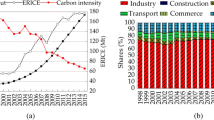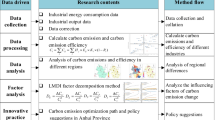Abstract
Low-carbon economy is becoming a new approach to optimize economic development, ensuring energy security and coping with climate change. As one of the important emission sources of greenhouse gases (GHG), the industrial sector should be prioritized in the development of low-carbon economy. In this study, the carbon emission from industrial energy use of Chongqing is accounted. On basis of industrial carbon emission (ICE) accounting, main factors responsible for industrial CO2 emission are identified and quantitatively analyzed using the Log-Mean Divisia Index method. The factors influencing ICE include energy mix, energy intensity, industrial structure and industrial output. It is found that the industrial output is the main driving force of ICE. The energy structure performs as a negative factor in carbon emission growth. By means of decomposing the influencing factors, several policy proposals were suggested for policy makers to build a low carbon city.
Similar content being viewed by others
References
Al-Ghandoor A, Phelan P E, Villalobos R, Jaber J O (2010). Energy and exergy utilizations of the U.S. manufacturing sector. Energy, 35(7): 3048–3065
Ang B W (2004). Decomposition analysis for policy making in energy: Which is the preferred method? Energy Policy, 32(9): 1131–1139
Ang B W (2005). The LMDI approach to decomposition analysis: A practical guide. Energy Policy, 33(7): 867–871
Bhattacharyya S C, Ussanarassamee A (2004). Decomposition of energy and CO2 intensities of Thai industry between 1981 and 2000. Energy Econ, 26(5): 765–781
Casler S D, Rose A (1998). Carbon dioxide emissions in the U.S. economy: A structural decomposition analysis. Environ Resour Econ, 11(3/4): 349–363
Druckman A, Jackson T (2009). The carbon footprint of UK households 1990–2004: A socio-economically disaggregated, quasi-multiregional input-output model. Ecol Econ, 68(7): 2066–2077
Hoekstra R, van den Bergh J C J M (2003). Comparing structural decomposition analysis and index. Energy Econ, 25(1): 39–64
IPCC (2006). IPCC guidelines for national greenhouse gas inventories. http://www.ipcc.ch/ipccreports/methodology-reports.htm
IPCC (2007). Summary for Policymakers of the Synthesis Report of the IPCC Fourth Assessment Report. Cambridge: Cambridge University Press, 2007
Lee K, Oh W (2006). Analysis of CO2 emissions in APEC countries: A time-series and a cross-sectional decomposition using the log mean Divisia method. Energy Policy, 34(17): 2779–2787
Li Y M, Fu J F (2010). Structural decomposition analysis on carbon emissions growth embodied in exports in China. China Population. Resources and Environment, 20(8): 53–57 (in Chinese)
Liu L C, Fan Y, Wu G, Wei YM (2007). Using LMDI method to analyze the change of China’s industrial CO2 emissions from final fuel use: An empirical analysis. Energy Policy, 35(11): 5892–5900
Ma C, Stern D I (2008). China’s changing energy intensity trend: A decomposition analysis. Energy Econ, 30(3): 1037–1053
Oh I, Wehrmeyer W, Mulugetta Y (2010). Decomposition analysis and mitigation strategies of CO2 emissions from energy consumption in South Korea. Energy Policy, 38(1): 364–377
Shrestha R M, Anandarajah G, Liyanage M H (2009). Factors affecting CO2 emission from the power sector of selected countries in Asia and the Pacific. Energy Policy, 37(6): 2375–2384
Sovacool B K, Brown M A (2010). Twelve metropolitan carbon footprints: A preliminary comparative global assessment. Energy Policy, 38(9): 4856–4869
Wachsmann U, Wood R, Lenzen M, Schaeffer R (2009). Structural decomposition of energy use in Brazil from 1970 to 1996. Appl Energy, 86(4): 578–587
Zha D L, Zhou D Q, Zhou P (2010). Driving forces of residential CO2 emissions in urban and rural China: An index decomposition analysis. Energy Policy, 38: 3377–3383
Zhang M, Mu H L, Ning Y D, Song Y C (2009). Decomposition of energy-related CO2 emission over 1991–2006 in China. Ecol Econ, 68(7): 2122–2128
Zhao M, Tan L R, Zhang W G, Ji M H, Liu Y, Yu L Z (2010). Decomposing the influencing factors of industrial carbon emissions in Shanghai using the LMDI method. Energy, 35(6): 2505–2510
Zhao X, Long R Y (2010). The status and decomposition model of carbon emissions for Jiangsu Province. China Population. Resources and Environment, 20(7): 25–30 (in Chinese)
Zhou S Y, Chen H, Li S C (2010). Resources use and greenhouse gas emissions in urban economy: Ecological input-output modeling for Beijing 2002. Commun Nonlinear Sci Numer Simul, 15(10): 3201–3231
Author information
Authors and Affiliations
Corresponding author
Rights and permissions
About this article
Cite this article
Yang, J., Chen, B. Using LMDI method to analyze the change of industrial CO2 emission from energy use in Chongqing. Front. Earth Sci. 5, 103–109 (2011). https://doi.org/10.1007/s11707-011-0172-3
Received:
Accepted:
Published:
Issue Date:
DOI: https://doi.org/10.1007/s11707-011-0172-3




